Putting the buzz back into school grounds Teach article
Dave Goulson and Ben Darvill from the Bumblebee Conservation Trust at the University of Stirling, UK, explain why these furry insects are under threat – and what schools can do to help.
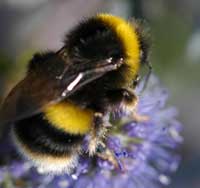
buff-tailed bumblebee,
Bombus terrestris
Bumblebees are among the most familiar and endearing of garden insects. Chubby insects with yellow and black stripes that are recognisable, bumblebees are widely featured in children’s story books, cartoons, greetings cards and advertising logos. Yet most people are unaware that there is a distinction between bumblebees (genus Bombus) and the honeybees from which we get honey (genus Apis), although they are quite different in appearance.
It is also not widely recognised that there are lots of different species of bumblebee, with very different colour patterns, many of which can be seen in almost any garden or park in Europe. In fact there are about 250 known species of bumblebee (~65 in Europe), found throughout the cooler parts of the northern hemisphere. Unfortunately for bumblebees, this region also contains much of the world’s human population and the most intensive agricultural regions. Probably as a result of this, many bumblebees appear to be undergoing dramatic declines in range.
This decline has drawn considerable media attention, which is generally positive, but it has led to some confusion. Articles in various national newspapers have claimed that bumblebees are “threatened with extinction”, yet, paradoxically, they remain a common sight in gardens. In fact most bumblebee species have declined greatly, and have disappeared from intensively farmed areas.
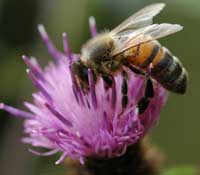
In the UK, three of 26 native species have become locally extinct, and around ten more have suffered range losses of greater than 70% in the last 60 years. However, a small number of species appear to be able to cope with intensive farming and remain widespread and reasonably abundant throughout Europe. These species appear to do particularly well in gardens, exploiting the range of flowers to be found there. In almost any location in Europe, planting a few square metres of bee-friendly flowers will attract at least five bumblebee species, often more.
So why have some species undergone drastic declines while others remain abundant? Recent studies suggest a possible answer. It seems that rare species tend to be more specific in their feeding requirements.
All bumblebees feed exclusively on nectar, which provides sugar (carbohydrates) for energy, and pollen, which is their sole source of protein for growth. Many of the rarer species such as Bombus ruderatus, the ruderal bumblebee, and the short-haired bumblebee, Bombus subterraneus, are heavily dependent on legumes (Fabaceae) as their major source of pollen. In particular red clover, Trifolium pratense, seems to be a favourite with bumblebees.
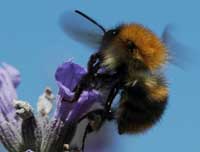
Red clover was once a very common plant in Europe as it was widely grown as a fodder crop (it is also a favourite with horses) and as a ley crop to boost soil fertility (it is able to fix atmospheric nitrogen via mutualistic bacteria in its root nodules). It was also a common plant on the unimproved, nutrient-poor pastures and hay meadows which covered much of lowland Europe. In the mountains of southern Poland, which have largely escaped agricultural intensification and where horses are still widely used for farm transport, red clover leys are still common and rare bumblebees thrive.
In contrast, in western Europe the advent of artificial fertilisers and mechanisation in the middle of the 20th century led to the abandonment of clover leys, and most pastures and hay meadows have either been ‘improved’ through ploughing and reseeding, or turned over to arable production.
The net result of these changes is that wildflowers in general, and red clover in particular, are now much less abundant, which is almost certainly behind the decline in bumblebees. In Europe, the best places for rare bumblebees are isolated pockets of habitat that have escaped agricultural intensification, such as Salisbury Plain in the UK and the Causses du Larzac in France (both owned by the military) and remote areas where farming has changed little such as the Outer Hebrides, Scotland and the mountains of Central Europe.
So what can we do to halt or reverse the decline of the bumblebee? Below are some ideas of how schools can help.
Projects with bumblebees
I. Create a wildflower garden
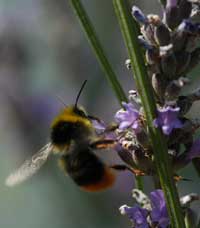
Bumblebees are very easy to attract to a wildlife garden. Wildflower seeds are now widely available from specialist suppliers. A selection of excellent bumblebee flowers are given below, all of which have a broad geographic range in Europe:
- Viper’s bugloss, Echium vulgare
- Foxglove, Digitalis purpurea
- Tufted vetch, Vicia cracca
- Comfrey, Symphytum officinale
- Red clover, Trifolium pratense
- Borage, Borago officinalis (native to continental Europe)
- Knapweed, Centaurea spp.
- Poppy, Papaver rhoeas
- Sainfoin, Onobrychis viciifolia
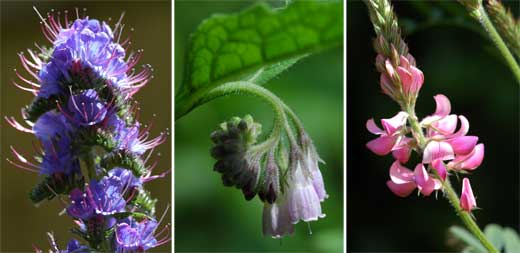
Sow any combination of these directly into a well-tilled soil in September or March, either in separate patches or mixed together. Weed occasionally to remove grasses and other invasive weeds. By summer of the first year, some of the plants will have come into flower. Try to identify the bumblebee species that are attracted, using the excellent colour key on the website of the Natural History Museum, London, UK. In the UK, several good identification guides are available, among the best of which is Prys-Jones & Corbet (1987). This also covers most of the more common species in much of mainland Europe.
Record which species of bumblebee visit which flowers. The feeding preferences of the different species are strikingly different. Bumblebee species vary greatly in the length of their tongue, and tend to visit flowers of an appropriate depth. Thus foxgloves and red clover are mostly visited by the very long-tongued garden bumblebee, Bombus hortorum, whereas viper’s bugloss and poppies, which have shallower flowers, are visited by a broad range of species with shorter tongues, such as B. terrestris. This behaviour reduces competition between the different species.
II. Providing nest sites for bumblebees
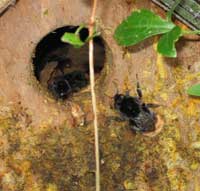
bumblebee nest traffic. This
nest is in an old bird box that
had been left on the ground
Few people have seen a bumblebee nest as they are usually well hidden, but it is relatively easy to provide artificial nest sites for bumblebees. All they need is a dark, draught-free and fairly dry cavity with a small access hole, preferably placed in a shady, quiet corner, such as the bottom of a hedge, or under a shrub. A paving slab placed over a football-sized cavity in the soil is pretty effective. Just make sure there are one or two gaps for the bees to get in.
Similarly, a piece of thick plywood placed on the ground amongst long grass seems to be quite attractive as a nest place for carder bees (e.g. Bombus pascuorum), although it works best if left in place for a year or two.
Alternatively, a few old bricks and/or planks of wood can be used to construct a chamber roughly 15 cm x 15 cm by 10 cm high, again leaving a small gap (about 2 cm wide) at ground level for the bees to get in. A few dried leaves, dried moss, kapok, or bits of an old bird’s nest should be added, which the bees will use to insulate their nest. The more nest sites that are provided, the more likely it is that one will be found and used.
It is noticeable that once a nest site has been used once, it is very often reoccupied the following year. It seems likely that queens searching for nest sites use the faint smell of an old nest as a good indication that the site is suitable for nesting. Thus it is best to leave nest sites in place for many years; the longer the better, for once they are eventually discovered by a queen and used for nesting, they are then likely to be used over and over again.
Once a nest is established, there are many observations that can be made. How often do bees leave/ return to the nest? What proportion of bees are carrying pollen on their legs? How is nest activity affected by temperature and rainfall?
III. Bumblebee recording
At present we do not have detailed information on the distributions of bumblebee species across Europe. Schools can play a valuable role by sending in records of the bumblebee species present in their area. Such data are absolutely vital if we are to develop sensible conservation strategies for bumblebees, yet even in the UK (which is relatively well studied) there are many areas where there are currently no bumblebee recorders. Recording sheets can be downloaded from the Bumblebee Conservation Trust websitew1, and should be returned to the Trust. Keen students can, for a small fee, join the Trust and receive a regular newsletter which details various events and activities.
References
- Prys-Jones E, Corbet SA (1991) Bumblebees. Richmond, London, UK: Richmond Publishing Co. Ltd. ISBN 0855462574
Web References
- w1 – The Bumblebee Conservation Trust website contains more information about bumblebees, identifying and encouraging them, and much more.
Resources
- Goulson D (2003) Bumblebees: Their Behaviour and Ecology. Oxford, UK: Oxford University Press
- Some UK specialist seed suppliers are:
Review
Bumblebees are extremely important native pollinators and are disappearing dramatically across Europe – an environmental disaster that seems to be caused by changes in land use.
This article is of great interest to teachers of the life sciences, for both environmental education and ethology. The hands-on activities can be applied in different ways in both primary and secondary schools, although they might be difficult for inner-city schools because of space requirements. The activities may encourage students to improve their knowledge of science through nature observation – and could help to prevent the insects’ extinction.
Immacolata Ercolino, Italy





